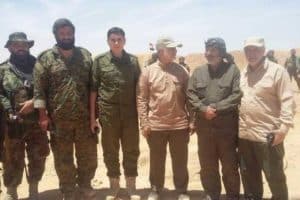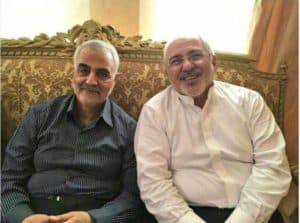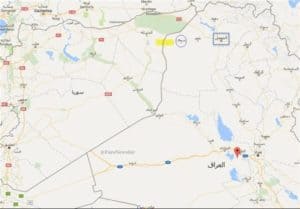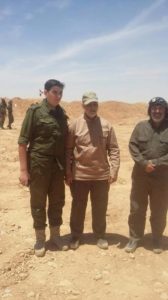
Photo 1: Qassem Soleimani allegedly near the Syrian border with Iraqi militias, posted May 29.
Major General Qassem Soleimani, the chief of the Islamic Revolutionary Guard Corps’ extraterritorial operations branch the Qods Force, has been photographed with Iranian-backed Iraqi militias of the Popular Mobilization Forces (PMF) in the northwestern countryside of Iraq near the Syrian border. The photo’s precise location and date are yet unconfirmed; it surfaced on May 29 on pro-regime social media and propaganda outlets.

Photo 2: Soleimani and Zarif, posted May 31.
Two days later, another photo of Soleimani emerged on social media; this time with Iranian Foreign Minister Mohammad Javad Zarif in Iran. It was reportedly taken after Monday’s controversy surrounding a former Iranian parliamentarian’s accusations against Zarif, in which the figure had accused the foreign minister of surrendering Soleimani to the US in exchange for permitting Iran to be taken off the blacklist of the Financial Action Task Force on Money Laundering (FATF).
Answering directly to Supreme Leader Ali Khamenei, Soleimani is in charge of the Islamic Republic’s Iraq portfolio.
After a week-long push, the PMF reached the border village of Um Jaris in northwestern Iraq by May 29. The offensive itself was a component of Operation Muhammad Rasulollah II which was launched last month at Qayrawan, west of Mosul. Backed by the Iraqi air force, ground forces are advancing toward Baaj, another border area to the south, according to the PMF.
An Iraqi Shiite commander told The Associated Press that forces entered two Syrian villages for a couple of hours “to convey a message to the Americans and (Kurdish-led) Syrian Democratic that we are able to do it.”
The PMF is the umbrella organization of diverse Iraqi militias formed in 2014 that is dominated by Guard-backed figures and has become an official part of the state.

Map 1: Location of PMF units by Syrian border, May 29. Credit: Fars News Agency.
Iraqi Prime Minister Hayder al Abadi confirmed in a press conference on May 30 that Iraqi Security Forces would coordinate with the PMF to establish border security.
The PMF has reaffirmed its goal to control the border area with Syria. Guard-backed Iraqi militias have been messaging that goal since the launching of the Mosul campaign. Hadi al Ameri, Badr Organization chief and a senior PMF figure, told the media after forces reached the border this week that “the Americans will not be allowed to control the border.” Abu Mahdi al Muhandis – PMF operations commander and designated global terrorist who is close to Soleimani – announced on May 30 that military operations to fully retake the border areas with Syria would continue. The commander of the PMF’s 2nd Brigade – which is linked to the Imam Ali Combat Division, tied to the Imam Ali shrine in Najaf and loyal to Grand Ayatollah Ali Sistani – confirmed the plan and specified that forces would head toward the major Qaim border crossing to the south.
A PMF spokesman has called for linking with pro-Syrian-regime forces advancing toward the Iraqi border, according to comments that were carried in Western media. The US could potentially disrupt that effort by continuing to hold the Tanf border crossing and supporting the advance of US-backed Syrian forces into Deir Ezzor by the Iraqi border.
Iraqi militias that are members of the PMF are assisting the Syrian regime. For instance, the Imam Ali and the Sayyid al Shuhada Brigades are active in northwestern Iraq and southeastern Syria near Tanf, where the US last month struck a pro-regime convoy that included Iraqi militiamen.
The PMF units participating in the latest operation in northwest Iraq include Tehran-controlled and shrine militias, as well militias linked to the Islamic Supreme Council of Iraq, several of which have received support from Iran. The participating units also include Yezidis – reportedly 500, according to Kurdish media – who defected last month from Kurdish Peshmarga to join the PMF after Muhandis convinced and offered them the opportunity to retake the Yezidi village of Kocho and surrounding areas near Shingal that has been under the Islamic State’s control since 2014.
The shrine militias directly answer Sistani and are not amenable to Khamenei’s influence, though they have cooperated with Guard-Corps elements within the framework of the PMF during the war against the Islamic State. Following the latter’s anticipated defeat, Iraq is expected to witness an intensified power struggle across the political spectrum including between Tehran and Najaf, Iraq’s powerful center of the Shiite clergy led by the 86-year old Sistani. Soleimani and the Qods Force will continue their mission of advancing and protecting the Islamic Republic’s interests in Iraq.

Photo 3: Soleimani near the Syrian border, posted May 29.








3 Comments
As i’ve noticed, I don’t get printed. But still, one has to ask how soleimani still walks this earth. With so much American blood on his hands, I find it difficult to believe he still exists. Only conclusion has to be collusion. Will he be allowed to do what “THEY” feel he must do, than right the wrong? Or has the west bundled him in with the likes of Japanese scientists from Manchuria and German missile engineers after wwii? It’s so hard for me to see this occur. Again. Maybe a courageous individual can help this out. But I doubt they exist anymore.
Iran appropriated Iraq because Obama unplugged US Forces and influence from Iraqi tribes, and the government in 2011. This vacuum was the filled simultaneously by the Iranian-Qods Republican Guards & ISIS. The Iranians ain’t going anywhere even if ISIS is destroyed.
dont just take pix, KILL HIM!